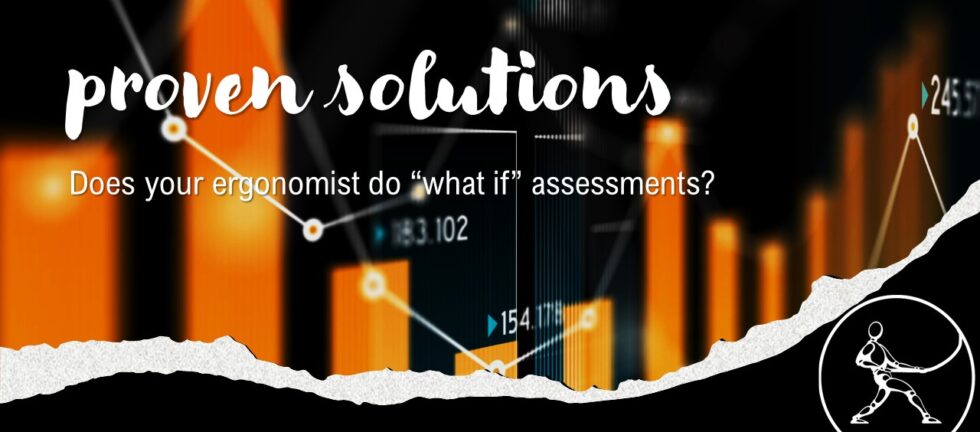We’ve always been proud of our quantitative approach to ergonomics. We use detailed analysis tools to determine whether work demands are acceptable, and we evaluate potential solutions against the same standards.
Doesn’t everyone do this?
Believe it or not, no! Many companies use checklists or score-based tools such as Rapid Upper Limb Assessment (RULA) or the Ovako Working Posture Analysis System (OWAS), to decide whether demands exceed or fall within guidelines. Ergonomists working in automotive assembly environments often use internally-defined criteria for tool weights, tote weights, etc. When frequency is consistent (e.g. one car per minute), it’s possible to create reference standards for simple tasks that are typically performed once per cycle. For example, ergonomists can set guidelines for tote weight based on average frequencies, if the totes are all the same size, and they are handled at roughly the same frequency. If the tote weighs more than the specified 13 kg limit, for example, the products need to be put in a smaller tote or a lifting device is required. But when you use one number as a “go/no go” threshold, you’ll overprotect in some cases, and under protect in others. The worker who loads 13 kg totes to the top shelves all day might be at higher risk than a worker in an area where the totes are at waist height.
Why is measuring and evaluating quantitatively important?
We dive deeper to better understand the limits for specific combinations of force, body position, and repetition. The tasks that our clients ask us to assess tend to be complex – pulling wrenches in constrained positions, reaching over obstacles to use heavy tools, or rotating amongst a set of specific jobs. We use a “risk index” to show just how far the demands are above (or below) the guidelines. If a report includes more than one issue, the client can prioritize the highest risk issue first.
‘What if’ assessments
Using this approach also lets us complete detailed “what if” assessments. When you use one number, say “13 kg tote weight limit”, then the only solutions that will address the “weight” problem are a lighter tote or a mechanical device. Our approach allows us to explore other options; we can explore the effects of changing the height of the tote conveyor, changing the handles on the tote, or removing obstacles to allow the worker to minimize reach.
During our debriefing meetings, when we share the results of the analysis, a lot of ideas are generated, and we’re often asked, “What if we implement this and that?” Or “What if we implement only this one thing, and not the other?” People want to know which combination of changes will bring the demands within acceptable limits. The analysis tools that we use allow us to predict the impact of changes in the amount or direction of force, effort frequency, duration, or posture (including height, reach, and type of grip). If you’re going to invest money in an intervention, we want to assure you that the change will be effective! When we have identified solutions that will reduce the risk, we also want to be sure that they will actually work in your environment. For example, a hoist might mitigate the risk of back injury, but we also need to ensure that it will be efficient, and that the supporting structure will fit in the available space.
A quantitative approach also applies in office environments. For example, if the keyboard is 5 cm higher than elbow height when the seat is adjusted perfectly, we know we either need to lower the keyboard by 5 cm, or raise the seat and provide a 5 cm footrest. If we choose the keyboard tray, we’ll need to make sure it can adjust to 5 cm below the desk, and that the device will be compatible with the desk. If we choose a footrest and higher chair, we need choose a footrest that can be adjusted to 5 cm high, and ensure that the chair will go high enough. Measuring helps us make recommendations that are easy to implement and more likely to resolve the issue.
Many clients also seek ergonomic work strategies (EWS) (or ‘best practices’) as a means of reducing the risk until engineering controls can be implemented. An EWS identifies the best way for workers to complete a task. Our quantitative approach can help here, too. For example, many heavy equipment operators climb in and out of the cab using only one hand. (Safety professionals encourage 3 points of contact, to prevent slips and falls.) One of our EWS studies showed that using both hands when climbing in and out reduces the load on the shoulder, back, and knee. Drivers use their arms to support some of their body weight while climbing.
Measuring our effectiveness
We are just launching some initiatives that will measure the effectiveness of our micro-learning and our “Move it” (stretch and strength) programs. We’re excited at the prospect of quantifying how well our programs and recommendations create skills, reduce discomfort, improve productivity, quality, and engagement.
Micro-learning and “Move-it” are only small parts of a successful ergonomics program, so perhaps the impact won’t be as impressive as we’re hoping. However, we believe that seeking these measurements is the right thing to do. Wouldn’t it be amazing for us to be able to say, if you implement this series of training sessions, you can expect a 15% reduction in MSD injuries, and a 10% improvement in employee retention? What if we could say that implementing a lift table reduced back injuries on that job by 40% and improved productivity by 15%?
Need some help to identify and evaluate a solution to an MSD hazard? We can help! Click here to find out more or contact Carrie@TaylordErgo.com.


